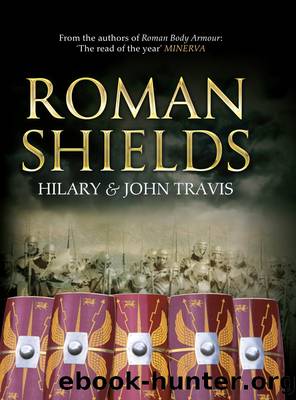Roman Shields: Historical Development and Reconstruction by Hilary & John Travis

Author:Hilary & John Travis
Language: eng
Format: epub
Publisher: Amberley Publishing
Published: 2014-06-11T16:00:00+00:00
Fig 65. Constructing the plyboard shield board: (a) front view; (b) rear view. (Artwork by J. R. Travis)
Roman glues would have been organic, although possibly not vegetable-based as these may not have offered sufficient strength â more likely they were fish- or animal-based. Animal-based adhesives have been used throughout history, in concentrated form as glue, and in more dilute form as a size, to seal surfaces prior to application of painted surfaces. This is traditionally made by boiling up rabbit skins, animal hooves and similar inedible animal by-products. It would not only provide a strong bond, holding together the layers of ply, but would serve to fuse the board to a surface fabric or leather coating, sealing the surface prior to painting. Being of animal origin, on combustion, this type of glue could appear visually and chemically similar to the âbubbly charâ reportedly found on the surface of the Doncaster shield board (Biek, 1978, 269).
Download
This site does not store any files on its server. We only index and link to content provided by other sites. Please contact the content providers to delete copyright contents if any and email us, we'll remove relevant links or contents immediately.
| Africa | Americas |
| Arctic & Antarctica | Asia |
| Australia & Oceania | Europe |
| Middle East | Russia |
| United States | World |
| Ancient Civilizations | Military |
| Historical Study & Educational Resources |
Magic and Divination in Early Islam by Emilie Savage-Smith;(1498)
Ambition and Desire: The Dangerous Life of Josephine Bonaparte by Kate Williams(1342)
Bohemians, Bootleggers, Flappers, and Swells: The Best of Early Vanity Fair by Bohemians Bootleggers Flappers & Swells- The Best of Early Vanity Fair (epub)(1341)
Papillon by Henry Charrière(1305)
Twelve Caesars by Mary Beard(1253)
Operation Vengeance: The Astonishing Aerial Ambush That Changed World War II by Dan Hampton(1134)
What Really Happened: The Death of Hitler by Robert J. Hutchinson(1126)
London in the Twentieth Century by Jerry White(1110)
Time of the Magicians by Wolfram Eilenberger(1085)
Twilight of the Gods by Ian W. Toll(1083)
The Japanese by Christopher Harding(1081)
Lenin: A Biography by Robert Service(1041)
The Devil You Know by Charles M. Blow(983)
A Social History of the Media by Peter Burke & Peter Burke(936)
Freemasons for Dummies by Hodapp Christopher;(921)
Napolean Hill Collection by Napoleon Hill(901)
Henry III by David Carpenter;(890)
The Churchill Complex by Ian Buruma(879)
The Rise and Triumph of the Modern Self by Unknown(877)
